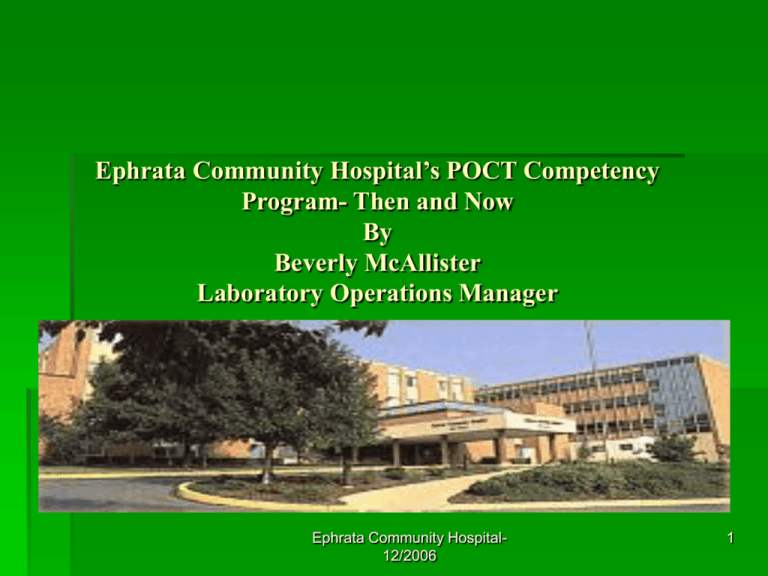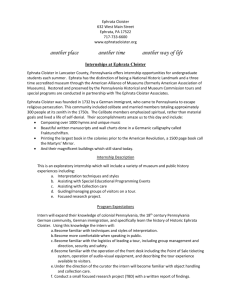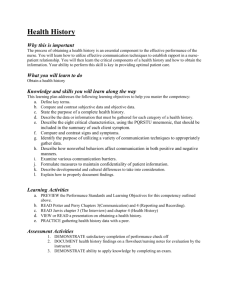CAP REGULATIONS- cont.
advertisement

Ephrata Community Hospital’s POCT Competency Program- Then and Now By Beverly McAllister Laboratory Operations Manager Ephrata Community Hospital12/2006 1 Demographics 135 bed Community Hospital Located in Lancaster County, PA 12 types of Point-of-care tests 6 POC tests brought in-house within the last 3 years Abbott P-Web brought in-house within the last 2 yearsprior to that QM2 in use for Precision PCx Physicians credentialed for PPT tests All Anesthesiologists trained/competencied on ISTAT Operator lists are on Excel Spreadsheets by instruments/test type Ephrata Community Hospital12/2006 2 POCT Operator Demographics Precision PCx Whole Blood Glucose Meter- 440 users Precision XTRA Whole Blood Glucose Users- 26 users Fecal Occult Blood- 150 users Gastroccult- 40 users Urine Pregnancy- 70 users Urine Dipstick- 90 users Avoximeter- 6 users Coaguchek- 12 users Cholestech- 5 users Nitrazine paper- 50 users ISTAT- 80 users Ephrata Community Hospital12/2006 3 POCT LOCATION DEMOGRAPHICS Precision PCx- all areas Precision XTRA- Ambulance Life Support Unit Fecal Occult Blood- ED, IMCU, CCU Gastroccult- ED, IMCU, CCU Urine Pregnancy- ED, SSU Urine Dipstick – FMU, ED Avoximeter- Cath Lab Coaguchek- Cancer Center Cholestech- Wellness Center Nitrazine Paper- FMU ISTAT- Anesthesia, Cath Lab, Respiratory, NICU Ephrata Community Hospital12/2006 4 REGULATIONS- JCAHOCurrent as of 9/2006 Standard- PC.16.30 Staff receive specific training and orientation for the tests they perform, and must demonstrate satisfactory levels of competence. Ephrata Community Hospital12/2006 5 Elements of Performance for PC.16.30 1. Staff members who perform testing have been oriented according to the hospital’s specific services. 2. Staff members who perform testing have been trained for each test he or she is authorized to perform. 3. Those staff members who perform tests that require the use of an instrument have been trained on the use and maintenance of that instrument. Ephrata Community Hospital12/2006 6 Elements of Performance for PC.16.30- cont. 4. Competence is assessed according to hospital policy at defined intervals. Testing always occurs at the time of orientation and annually thereafter. 5. Current competency is assessed using at least 2 of the following methods per person per test: Performing a test on a blind specimen Having the supervisor or qualified delegate periodically observe routine work Monitoring each user’s quality control performance Having written testing that is specific to the method assessed. 6. The director named on the CLIA certificate or qualified designee evaluates and documents evidence of orientation, training and competency. Ephrata Community Hospital12/2006 7 CAP RegulationsCurrent as of 10/31/06 POC.06700 Phase II Is there evidence that testing personnel have adequate, specific training to ensure competence? POC. 06800 Phase II Is there a current list of POCT personnel that delineates the specific tests that each individual is authorized to perform? Ephrata Community Hospital12/2006 8 CAP REGULATIONS- cont. POC.06900 Phase II Is there a documented program to ensure that each person performing POCT maintains satisfactory levels of competence? Ephrata Community Hospital12/2006 9 CAP Regulations- cont. NOTE: The records must make it possible for the Inspector to determine what skills were assessed and how those skills were measured. Some elements of competency assessment include, but are not limited to: 1. Direct observation of routine test performance, including patient prep, specimen handling, processing and testing 2. Monitoring the recording and reporting of tests results 3. Review of intermediate test results or worksheets, QC records, PT results, and PM records. Ephrata Community Hospital12/2006 10 CAP Regulations- cont. 4. Direct observation of performance of instrument maintenance and function checks 5. Assessment of test performance through testing previously analyzed specimens, internal blind testing samples or external PT samples 6. Evaluation of problem solving skills Ephrata Community Hospital12/2006 11 CAP Regulations- cont. Competency must be reassessed at least annually. During the first year that an individual is performing such patient testing, competency must be assessed every 6 months. All of the above elements that are applicable to an individual’s duties must be evaluated for that individual. The competency of physicians who perform POC tests may be established and reassessed through the credentialing process of the institution’s medical staff. Ephrata Community Hospital12/2006 12 The Journey began in 2000……… Staff development was doing the training for whole blood glucose testing and fecal occult blood- They trained all RNs on both tests regardless of where they were working I had no idea what other tests where being done in house and who was training them or if there was training No competency program existed at the time Units were hiding POC products in filing cabinets. They would not admit to performing the tests We had just gone live with QCM2 in the fall of 1999. That was the only operator list I had Ephrata Community Hospital12/2006 13 The journey continues…. First things first…. 1. Clean up the house 2. Identify what tests were being performed 3. Initiate competency program. 4. Initiate proficiency testing program 5. Comply with regulations. Ephrata Community Hospital12/2006 14 The journey continues….. Paper, Paper and more Paper……. The first competency program consisted of a written test and no more, for whole blood glucose testing and fecal occult blood. That was in 2002. The tests had to be completed and returned to me by the last week of December. That would give me enough time to grade them and update the operator certification in QCM2. It was a nightmare getting all of the tests back. Ephrata Community Hospital12/2006 15 The journey continues….. This process went on for several years. I added more written tests for those manual tests that did not have one or for those new products brought in-house. Staff development continued with the OCB and WBG training. I trained staff for all other tests. I also initiated a proficiency testing program and developed maintenance forms for the Precision PCx among other things. The process was becoming very painful-something had to give. Ephrata Community Hospital12/2006 16 The journey continues….. 2005- the straw that broke the camel’s back I had distributed all of the POCT competency tests to the nurse manager’s stating that if the staff did not complete and pass them as of 12/31/05, they would be locked out of the system and not be allowed to use the glucose meter. We’ll guess what happened!!!!! Ephrata Community Hospital12/2006 17 the straw that broke the camel’s back…….. I got a call around 0900 on 12/31/05 stating that no one could get into the glucose meter. Only one operator ID worked and all of the staff was using it. I told the nursing supervisor the reason for that was due to the staff not taking their competency exam and they were now locked out. To make the long story short, I had to come in and recertify all staff regardless of whether or not they took the exam. On 1/2/06, I met with the VP of Nursing, the nurse managers and staff development. Things started to change that moment. After thorough discussion of the regulations and the process currently in place, we were all on the same page. We all wanted to do a good job and meet each others needs as well as comply with the regulations. Ephrata Community Hospital12/2006 18 How did it all end…….. In 2006- the following changes were made: 1.All of the written competency exams were transitioned to Healthstream No more paper Nurse manager accountability POCT operator accountability Staff knows they will be locked out if the exams are not completed. 2. Receive a Terms/Hires document from HR every month so I can keep track of and update the Operators Users list in Excel and QCM3 3. Creation of Test specific Operator’s list in Excel 4. Review of POC test menu by department- was able to eliminate testing in some areas. 5. Developed written Training/Competency Program with training documents for all POC tests as well as a POCT Competency Assessment Form 6. Involved nursing with POCT Competency Program. Defined roles for POCT Coordinator, Nurse manager, Staff development and Nurse educator. 7. Addition of POCT coordinator assistant. 8. Development of POCT QI Report Card. Ephrata Community Hospital12/2006 19 There’s still work to be done….. 1. 2. 3. 4. Need to go back and retrain the nurse educators on the manual tests- There is no training documentation Get signature lists of all POCT operators performing manual tests in which QC is documented manually. This is so we can read the initials of each POC operator to allow them to receive credit for successfully performing QC. Initiate performance of testing unknown specimen for manual tests Training of POCT coordinator assistant. Ephrata Community Hospital12/2006 20 What have we learned……. 1. 2. 3. 4. 5. POCT coordinator is the leader and Leadership is the act of accomplishing more than the science of management says is possible!!! Nursing and the POCT coordinator need to work as a team to get the job done completely- Can’t do it alone Communication and understanding is key! Question-Why you are doing something? Is there value in it? Can it be done differently? Rome was not built in a day- A good program takes time to mature Ephrata Community Hospital12/2006 21 POINT-OF-CARE COMPETENCY ASSESSMENT FORM NAME:__________________________________________________________ DEPT.:____________________ OPERATOR ID:____________________ COMPETENCY ASSESSMENT FOR YEAR:_________________________ 1.All employees must have at least 2 competency assessment methods to be deemed competent for each test method performed. Healthstream Module is mandatory; therefore one of the other 5 methods MUST be completed. 2.As you complete a competency assessment method, date and initial the completion. If you are being observed, the observer MUST date and initial observation. 3.If you do not perform one of the test procedures listed, document N/A indicating “Not Applicable”. 4.Please keep this record in your files. Inspectors may ask for it. Test Method Completed Healthstream ModuleMANDATORY Direct Observation Monitor documenting test results Perform quality control Perform unknown specimen Perform proficiency test sample Precision PCX glucose meter Precision XTRA glucose meter Fecal Occult Blood Gastric Occult Blood Urine Dipstick Urine Pregnancy Nitrazine Test ISTAT Avoximeter Ephrata Community Hospital12/2006 22 ISTAT TRAINING DOCUMENT Name:_________________________________ Date:_______________________ Department:___________________________ Operator ID: _________________ GOAL: To Demonstrate competency in the use of the ISTAT System Evaluator’s Initials Identifies components of the ISTAT System _______________ Identifies patient using 2 patient identifiers _______________ Describes proper specimen collection _______________ Handles the specimen properly _______________ Fills and closes the cartridge correctly _______________ Inserts and removes the cartridge correctly _______________ Describes proper cartridge storage requirements _______________ Accurately enters data into the ISTAT _______________ Explains all prompts and displays _______________ Demonstrates access to stored patient results _______________ Describes what to do with patient results _______________ Describes the use of the Electronic Simulator _______________ Describes the care of the system _______________ Demonstrates docking the ISTAT _______________ Reviews Procedure _______________ EVALUATOR:__________________________________ DATE:_________________ Ephrata Community Hospital12/2006 23 URINE PREGNANCY TEST TRAINING DOCUMENT Name: ______________________________________ Date: ______________________ Department: ____________________________ GOAL: To Demonstrate competency in the use of the ImmunoCard Stat HCG Advantage Pregnancy Test Evaluator’s Initials Identifies proper storage requirements of the test card __________________ Identifies and describes correct QC material and usage __________________ Identifies patient using two patient identifiers __________________ Describes proper specimen collection __________________ Handles specimen properly __________________ Identifies correct specimen volume __________________ Knows how to handle a cloudy urine specimen __________________ Accurately dispenses specimen into test card __________________ States incubation time __________________ Accurately interprets results __________________ Correctly identifies result documentation form __________________ States situations that may call for retesting __________________ Describes invalid test results __________________ Explains “hook effect” and what to do if it is suspected __________________ Reviews procedure __________________ EVALUATOR: ___________________________________ DATE: _______________ Ephrata Community Hospital12/2006 24 POINT-OF-CARE TESTING ISTAT OPERATOR COMPETENCY LIST PARTIAL LIST YEAR: 2006 ISTAT COMPETENCY ASSESSMENT TYPES NAME DEPT OP ID WRITTEN TEST REVIEW OF QC BARR, MAGGIE ANESTHESIA 8679 X X X BEECH, ROBERT ANESTHESIA 6893 X X X BERKOWITZ, ALAN ANESTHESIA 8541 X X X COOK, ARLENE ANESTHESIA 438 X X X FAVORITE, SUE ANESTHESIA 6969 X X X MCKANE, ROBERT ANESTHESIA 6827 X X X NOLL, DAWN ANESTHESIA 7471 X X X BUCEK, JEANINE ANESTHESIA 3568 X X X CASSANO, DON ANESTHESIA 6888 X x x CICERO, LARRY ANESTHESIA 8453 X X X CULP, DAVID ANESTHESIA 4005 X X X JURGENSEN, MARCUS ANESTHESIA 7160 X X X ZANG, DICK ANESTHESIA 1970 X X X GARVIN, ROBERT ANESTHESIA 4685 X X X HILL, KATHY ANESTHESIA 3942 X X X KLICK, ROBERT ANESTHESIA 5847 X ON FMLA ON FMLA LEE, CHANG ANESTHESIA 6529 X X X MELAMED, BRIAN ANESTHESIA 9119 X X X MITCHELL, MARY CATH LAB 8631 X x x OBER, RAY CATH LAB 8535 x x RAMBO, DALE CATH LAB 8983 x x X Ephrata Community HospitalX 12/2006 UNKNOWN SPEC DIRECT OBS 25 Equipment Management Plan ECH Environmental Safety Committee QI Initiative/Goals Report Card - FY 2007 Indicator Target 7/06 8/06 9/06 1. Monthly preventative maintenance will have electrical checks completed according to schedule. 11 beds scheduled per month - 122 beds. Measurement: % of beds inspected in their appropriate month (7/1/06 – 6/30/07 (ES) Green = Average of 100% of beds completed in their specified month . Yellow = Average 90% of beds completed in their specified month. Red = ,Average of 80% of beds completed in their specified month. 100% of beds inspecte d in specifie d month 100 % 100% 100% 2. Rental equipment will have a current, accurate and separate inventory. Measurement: Numerator: # of items rented (equipment) vs the number of items with inspection sticker. (ES, DP) Green = 100%/month Yellow = 1 missed/month Red = 2 missed/month 100% per month 3. ISTAT users completing annual competency. Measurement: Numerator: Number of trained ISTAT users completing 2 forms of JCAHO approved competency requirements. Denominator: Total number of trained ISTAT users. (DG, BMc) Green = 25%/quarter, 100%/year Yellow = 15-20%/quarter Red = <15%/quarter 25%/ Quarter with 100% compet ent by 12/06 85% 10/06 11/06 12/06 1/07 2/07 3/07 4/07 5/07 6/07 100 % Ephrata Community Hospital12/2006 26 Any questions? Ephrata Community Hospital12/2006 27






